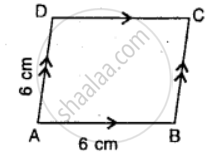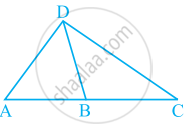Advertisements
Advertisements
प्रश्न
Write, giving reason, the name of the figure drawn alongside. Under what condition will this figure be a square.

उत्तर
Since, all the sides of the given figure are equal.
i.e. AB = BC = CD = DA = 6 cm
∴ The given figure is a rhombus.
This figure shall be considered as a square, if any angle is 90°.
APPEARS IN
संबंधित प्रश्न
How many diagonals does following have?
A convex quadrilateral
What is the sum of the measures of the angels of a convex quadrilateral? Will this property hold if the quadrilateral is not convex? (Make a non-convex quadrilateral and try!)
In Fig. 16.19, ABCD is a quadrilateral.
How many pairs of opposite sides are there?

A quadrilateral has three acute angles each measures 80°. What is the measure of the fourth angle?
In Fig. 16.21, the bisectors of ∠A and ∠B meet at a point P. If ∠C = 100° and ∠D = 50°, find the measure of ∠APB.

The consecutive sides of a quadrilateral have
ABCD is a trapezium in which AB || DC. M and N are the mid-points of AD and the respectively. If AB = 12 cm, MN = 14 cm, then CD =
Three angles of a quadrilateral are equal. If the fourth angle is 69°; find the measure of equal angles.
One angle of a hexagon is 140° and the remaining angles are in the ratio 4 : 3 : 4 : 5 : 4. Calculate the measures of the smallest and the largest angles.
One angle of a pentagon is 160° and the rest are all equal angles. Find the measure of the equal angles.
The angles of a quadrilateral are in the ratio 2 : 4 : 5 : 7. Find all the angles
What is the maximum number of obtuse angles that a quadrilateral can have?
In quadrilateral HOPE, the pairs of opposite sides are ______.
In quadrilateral WXYZ, the pairs of opposite angles are ______.
The number of obtuse angles in figure is ______.
If the sum of two angles is equal to an obtuse angle, then which of the following is not possible?
A pair of opposite sides of a trapezium are ______.
The common part between the two angles BAC and DAB in figure is ______.
In given figure, What is BD – DE?
What conclusion can be drawn from part of given figure, if DB is the bisector of ∠ADC?
